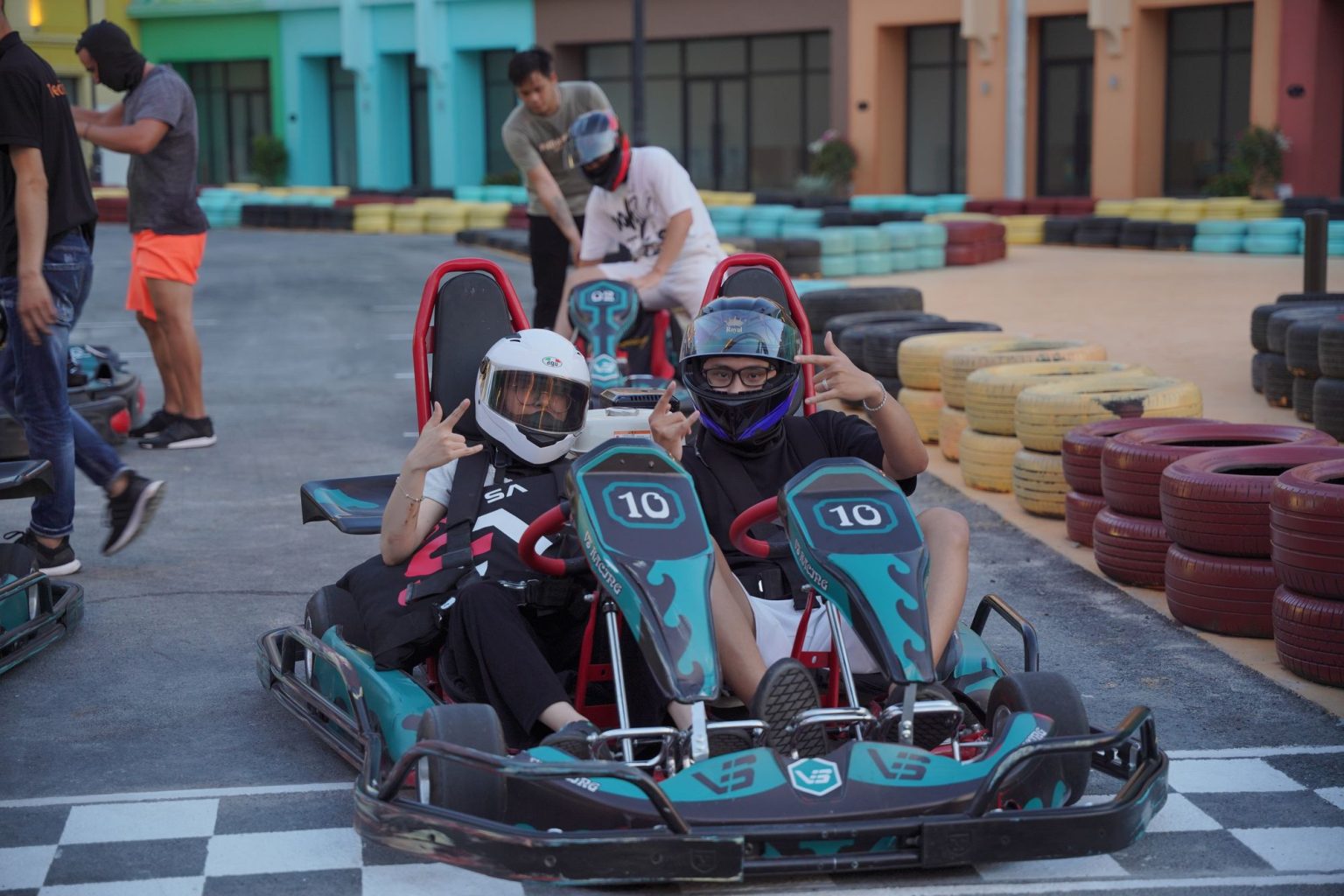
Vietnamese traditional games, deeply rooted in the rich heritage of Vietnam, not only entertain but also serve as a reflection of the values, customs, and shared joy of the Vietnamese people. From spirited boat races to the strategic moves in o an quan, each game carries a unique charm and plays a role in fostering community spirit. Discover 20 games that amplify Vietnamese traditional culture in this guide.
1. Popular traditional games in Vietnam that delight generations of Vietnamese kids
1.1. Tug of war (Keo co)
Tug of war, known as "kéo co" in Vietnamese, is a cherished traditional game played across various regions of Vietnam. While the specific rules may vary, the essence of the game remains the same, bringing joy to generations of Vietnamese children.
The game typically involves dividing the participants into two teams, irrespective of gender. Each team exerts its collective strength in a coordinated effort to pull the opposing team toward their side. The atmosphere is vibrant, with onlookers from the village cheering on the competitors with encouraging phrases like "do ta" and "co len."
1.2. Nu na nu nong
In this energetic game, players line up with their legs stretched out in front of them. In each pair facing each other, one person takes on the role of the striker. They tap their own leg and their partner's leg in a rhythmic sequence following the beat of the “nu na nu nống" song. When the song ends with the word "rut," the person whose leg should be tapped has to quickly pull it back. If they cannot do it in time and the striker taps them, they lose that round. They become the next striker, face a penalty, or must leave the game for another player to join. “Nu na nu nống” is among the easiest Vietnamese games, but it sure brings tons of joy.

1.3. Jumping rope (Nhay day)
“Nhảy dây” is one of the most common Vietnamese traditional games. It involves elastic bands linked together to form a long strand. Two players stand opposite one another and hold the ends of the strand. They secure the long strand for other players to jump over. Players can make it more challenging by jumping from low to high levels, such as starting with the string held at knee-level, then escalating to tummy-level, shoulder-level, or even as high as head-level. If a player comes into contact with the strand, they "lose" and become one of the two people holding the strand.
1.4. Hide and seek (Tron tim)
“Trốn tìm” is a classic childhood game that transcends generations. In this game, one player takes on the role of the seeker, closing their eyes and counting while the other participants find clever hiding spots. After counting to a designated number, the seeker begins looking for the hiding players. The thrill of the game lies in the hiders' ability to conceal themselves skillfully. Once a player is found, they may be the next seeker or incur a playful penalty.
1.5. Cat and mouse game (Meo duoi chuot)
This is a dynamic activity that starts with participants playing rock-paper-scissors to determine who plays the roles of the cat and the mouse. The remaining players form a circle by holding hands. Then, the chosen cat and mouse sit back-to-back in the center of the circle. When the starting signal is given, the mouse dashes away, and the cat chases it down.
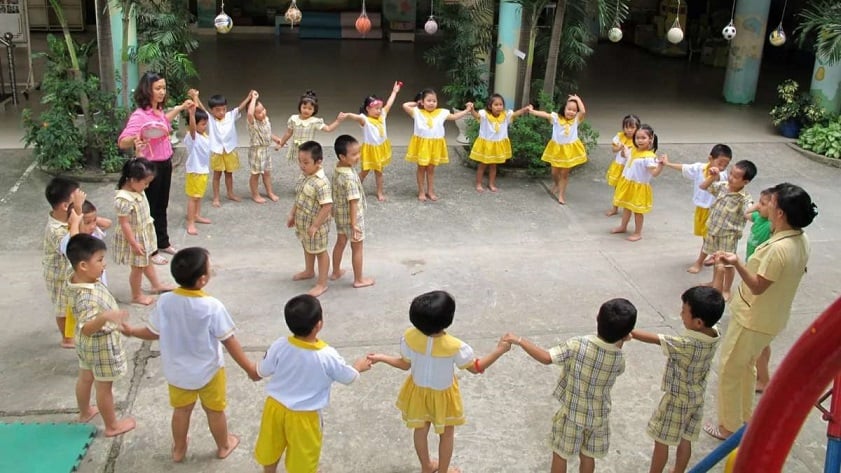
When the mouse reaches a spot of the circle, the two participants standing there must unlink their hands and raise them to create an exit for the mouse to run through. Then, when the cat reaches the spot, the two participants close in, preventing the cat from escaping, and the cat must seek an alternative exit. The game ends when the cat successfully "captures" the mouse.
1.6. Bamboo jacks (Choi chuyen)
This game is designed for 2-5 female players and includes 10 small sticks and a round, heavy object, like a tennis ball. Players hold the ball in their right hand, toss it into the air, and pick up the sticks one by one. If the ball falls to the ground, it is a missed turn.
The game progresses from picking up one stick per toss, two sticks per toss, and so on, up to 10 sticks. After 10 sticks, players switch to using two hands, passing the ball around in one, two, or three circles while singing: "Đầu quạ, quá giang, sang sông, trồng cây, ăn quả, nhả hột..." approximately 10 times. Points are tallied to determine the loser.
1.7. Hopscotch (Nhay lo co)
Hopscotch is typically played on a spacious, flat concrete or brick surface. A rectangular shape, approximately 4 meters long and 1 meter wide, is drawn. A straight line divides the rectangle in half, and five horizontal lines within the rectangle create ten small squares. At one end of the rectangle, a crescent moon shape is drawn, and at the other end, a horizontal line is drawn about 1 meter away from the rectangle, creating a standing throwing line.
One column is numbered from 1 to 5, and the corresponding column on the other side is numbered from 10 to 6 within the small squares. Each player holds a small, square tile that fits comfortably in their hand. To start the game, players stand at the throwing line.

The player closest to the center goes first. They throw the tile into square 1 without touching the lines. Then, they jump through squares 10 to 6, and upon reaching the crescent moon shape, they rest both feet and continue hopping from square 5 to square 1. The player must then kick the tile out of square 1 or bend down to pick it up, then jumps out of the square.
If the tile doesn't land outside the square, lands in a different square, or the player falls, they lose their turn. Moving to square 2, the player stands at the line, throws the tile into square 2, and repeats the process as in square 1. This continues for squares 3, 4, 5, and when progressing from squares 6 to 10, the player jumps from square 1.
After clearing all 10 squares, the player acquires a field. They stand at the center of the crescent moon, facing away from the squares, holding the tile, tossing it over their head, and the tile's landing square becomes their field. If the tile lands outside, they lose their turn.
The player who owns a field gets to rest when jumping to their field. If they acquire a second field, they attempt to throw the tile into an adjacent square to rest longer. Other players, when jumping to a field, must leap over it. To rest on someone else's field, they must pay a "toll" to the field owner, such as by enduring a light ear-pulling.
1.8. Dragon-snake game (Rong ran len may)
“Rồng rắn lên mây” is one of the many team-based traditional Vietnamese games that never fails to elicit laughter with each play. One person assumes the role of the "doctor" or host, while the rest form a line, holding onto the shirt or waist of the person in front of them.
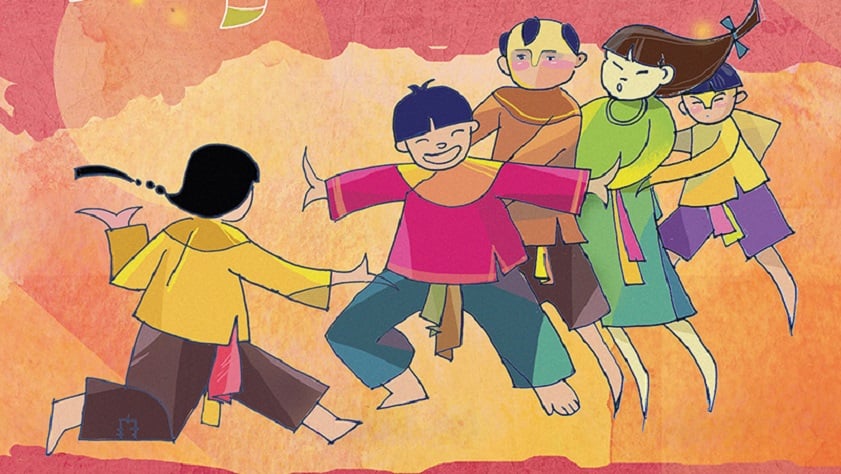
As the game begins, everyone sings the lively tune "rồng rắn lên mây, có cây lúc lắc..." while moving in circular patterns. Pausing in front of the "doctor's" house, they inquire about which section to choose. Once a section is selected, the "doctor" tries to catch the person standing in that section. The objective is to skillfully evade the "doctor's" grasp. If caught, the captured person becomes the new "doctor," carrying on the game with a fresh perspective.
1.9. Vietnamese blind man’s buff (Bit mat bat de)
In this simple yet engaging game, one participant is blindfolded, and the others form a circle around them. As the command “start” echoes, everyone moves around within the circle until the signal “stop” is given. The blindfolded person tries to catch someone within the circle. If the blindfolded player correctly guesses the captured person's name, the caught participant switches places and becomes the new blindfolded seeker. However, if the guess is incorrect, the blindfolded participant continues his or her pursuit.
1.10. Mandarin square capturing (O an quan)
This is considered an intellectual game with strategic elements, typically designed for two players. The game employs readily available materials, making it one of the most popular Vietnamese traditional games. With just a piece of chalk, a small brick, or some small stones, and a designated playing area, you can have a delightful and fascinating game of “Ô ăn quan.”
The playing board is a rectangle divided into 10 small squares, with each side having five symmetrically arranged squares. At both ends, two crescent moon shapes facing outward are drawn, symmetrically placed. The cleverest player strategizes to gain more pieces than their opponent. When the game concludes, the player with the most pieces is declared the winner.
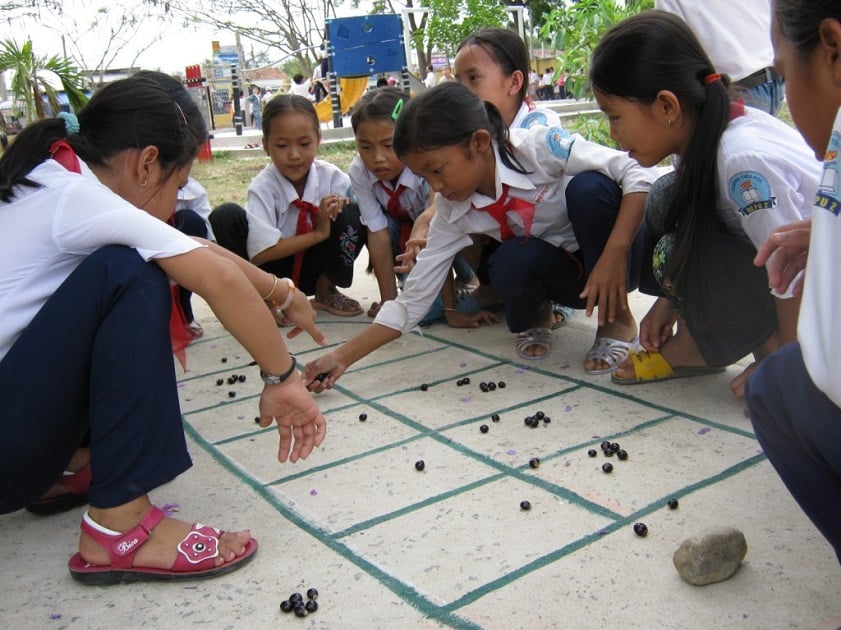
>>> Discover: 11 of the best Vietnamese board games to play with your family and friends
2. Unique Vietnamese traditional games on Tet holiday
2.1. Di ca kheo
This is a distinctive Vietnamese traditional game enjoyed during the Tet holiday. Crafted from tall and robust bamboo poles with two carved bamboo pieces on top as pedals, this game is a source of laughter during the festive season.
Players take turns standing on the bamboo poles, skillfully moving towards the finish line. The one who maintains balance and reaches the destination first claims victory. The game's simplicity and joy make it a cherished part of Tet celebrations, attracting both participants and spectators alike.
2.2. Di cau Kieu
This is a well-known traditional folk game in the Red River Delta of Northern Vietnam, but its organized presence is now limited. The game typically takes place in villages or rural areas with ponds or communal wells. Villagers select a straight bamboo pole, tie one end to the bank, and fasten the other end to a post in the middle of the pond.
A red envelope, or prize, is attached to the lower end of the bamboo pole. Participants, if they manage to walk from the bank to the end of the bamboo bridge, can claim the red envelope or prize. This game is not only entertaining but also challenging, requiring players to maintain good balance.
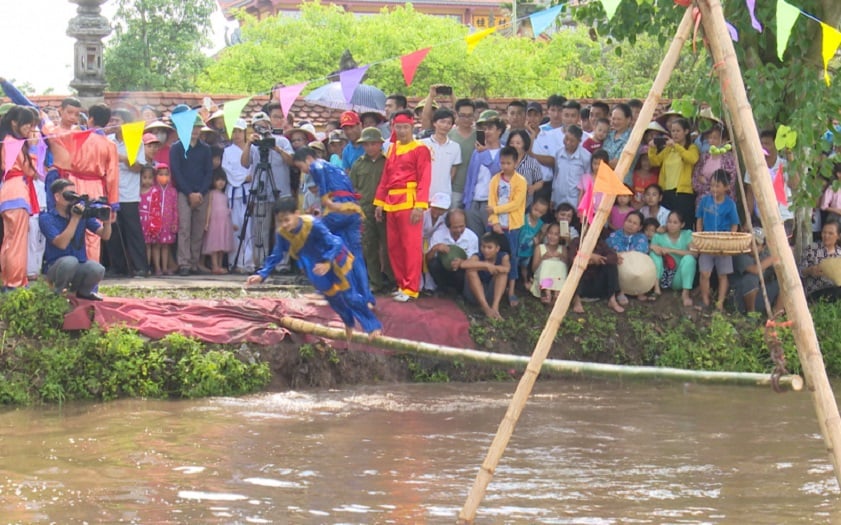
2.3. Hit the hanging clay pots (Dap nieu dat)
“Đập niêu đất” is a traditional game that adds excitement to festive occasions. In this game, clay pots are suspended from above, presenting a challenging target for participants.
Players are blindfolded and given a stick or a tool to hit the hanging clay pots. The goal is to break the pots to reveal hidden prizes or treats inside. The swinging and unpredictable nature of the pots adds an element of difficulty to the game, requiring participants to rely on their instincts and aim.
2.4. Human chess (Co nguoi)
During Vietnamese festivals in villages and communal areas, traditional human chess games are often organized. It always attracts a large crowd of participants and spectators. The gameplay is based on the rules of chess, with the unique twist of using real people as pieces. The human chessboard is set on a flat, spacious area, with squares marked on the ground, resembling a traditional chessboard.
After arranging the "pieces" in their designated positions, two chess players make their entrance. Each player carries a multi-colored tail-switching rod to introduce themselves and command their respective forces. The player controlling the red pieces makes the first move, followed by the player controlling the black pieces. The turns continue alternately until the chess match concludes.
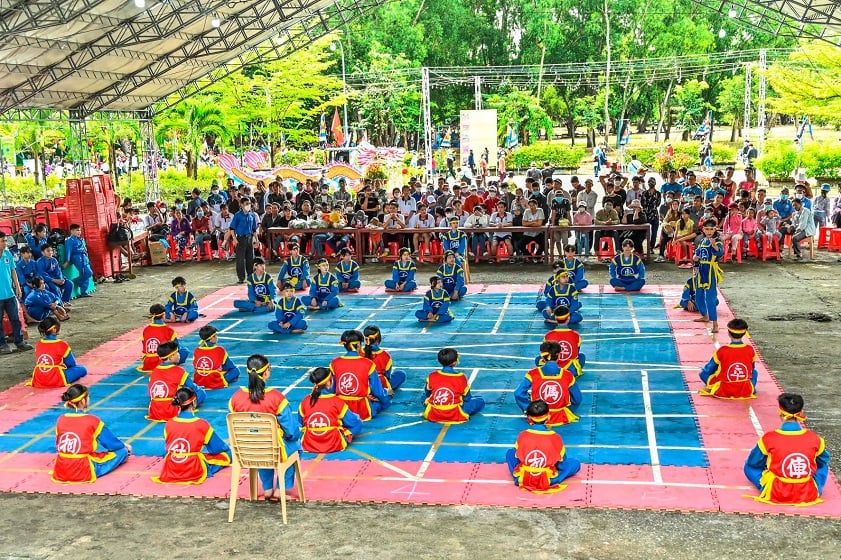
2.7. Catching a pig while blindfolded (Bit mat bat lon)
This is a game commonly seen during village fairs in rural areas of Vietnam. Each round involves one participant, blindfolded for added challenge in a sand-filled arena, and a pig. After being blindfolded, the player listens to the instructions from the audience to catch the pig. Although this sounds easy, it is quite difficult in reality. The game has a specified time limit, and the reward for the winner is the actual pig caught.
2.8. Bamboo swings (Danh du)
This is a traditional game that adds excitement to festive occasions, especially during Tet. The bamboo swings are set up in open areas, and individuals or couples take turns swinging high into the air. The swings are often decorated with colorful ribbons and flowers, enhancing the festive ambiance.
Participants use their legs to push and control the swing's motion, creating an entertaining experience for both the swingers and the spectators. Bamboo swings not only showcase the playful spirit of traditional Vietnamese celebrations but also provide a nostalgic way for people to come together and enjoy the festivities.

2.9. Wrestling (Dau vat)
“Đấu vật” is a longstanding traditional folk game that takes center stage during the Tet festival in Vietnam. Participants compete shirtless, wearing only a loincloth for ease of movement. The designated wrestling ring is marked as a circular area on an open field. As the competition begins, both wrestlers employ their strength and dexterity to engage in a spirited match. The wrestler who causes the opponent to fall or exceed the boundaries of the ring wins.
2.10. Boat racing (Dua thuyen)
Boat racing is a time-honored game that has graced Vietnam for generations. Beyond being a traditional folk game, it holds a significant ceremonial role connected to the water spirit. In this lively event, each racing boat is adorned with colorful flags, creating a vibrant spectacle. When the signal is given, competing teams channel their full efforts into paddling their boats, striving to be the first to cross the finish line and claim victory.

As we conclude our exploration of Vietnamese traditional games, we find ourselves immersed in the beauty of a cultural legacy preserved through the simple joy of play. These games, whether played in the heart of a bustling festival or in the quiet corners of a village, carry the weight of tradition and the lightness of laughter simultaneously.
To try these traditional Vietnamese games firsthand, travel to Vietnam. You can visit the country's top destinations, such as Hanoi, Ho Chi Minh City, Phu Quoc, Nha Trang, Hoi An, Ha Long, etc., and enjoy memorable Vietnam travel experiences. For accommodations in these cities, consider Vinpearl hotels and resorts. They offer luxurious rooms as well as world-class amenities like swimming pools, spas, gyms, restaurants, and bars. You can also pay a visit to VinWonders for diverse entertainment options, from thrilling rides to lively shows.


>>> Book rooms in Vinpearl Phu Quoc, Vinpearl Nha Trang, Vinpearl Resort & Golf Nam Hoi An, Vinpearl Resort & Spa Ha Long for accommodations while in Vietnam!










